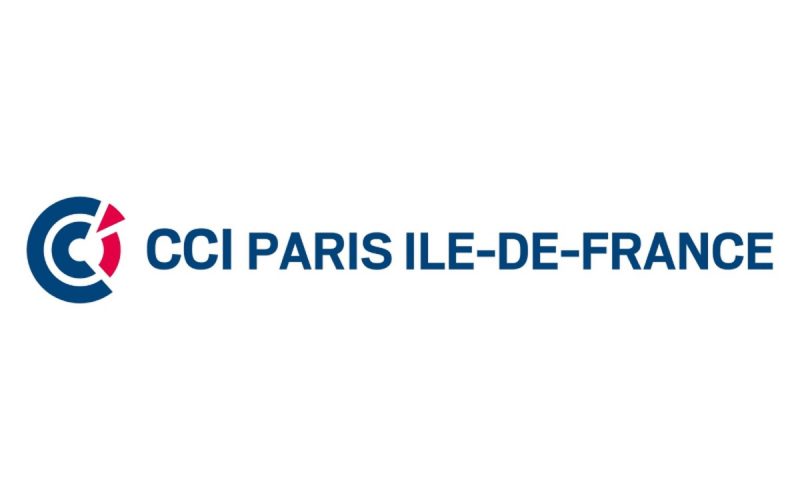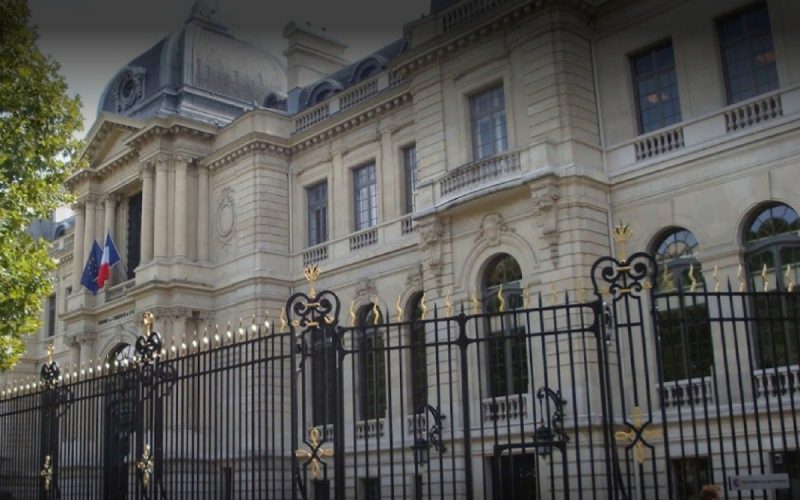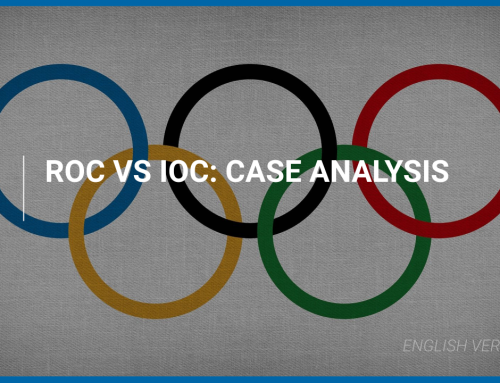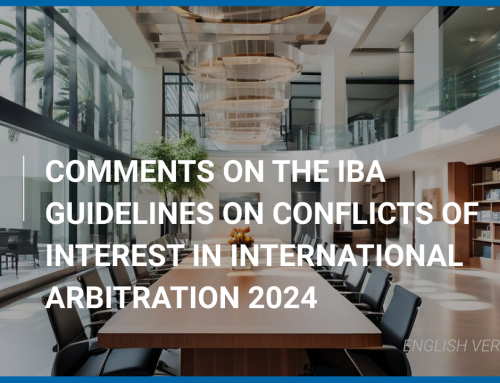Published and translated by the firm Winter – Dávila & Associés
Paris, 17 January 2022
Author: Gonzalo Chirinos Vidaurrazaga

Lawyer summa cum laude from the University of Lima (Peru) and Master in Transnational Arbitration and Dispute Resolution from Sciences Po Paris, France. He has been a member of the international arbitration team of the Paris office of Mayer Brown and is currently a Senior Associate in the dispute resolution area of Rodrigo, Elías & Medrano Abogados, in Lima. He is co-founder of Lima Very Young Arbitration Practitioners. He is a coach of the University of Lima team for international arbitration competitions, and teaches an introductory course on procedural law at the same university.
Would you like legal advice on international arbitration? Do not hesitate to contact us!
Introduction
The International Chamber of Commerce (“ICC”) is the organisation designed for the purpose of bringing business together and promoting trade between different countries of the world through the opening of markets and the free flow of capital. In order to achieve this objective, the institution is subdivided into Commissions with specific individualised functions aimed at acting and facilitating business interests.
An inevitable part of the conduct and development of any business activity is also the emergence of disputes. If we add to this the ease with which misunderstandings can occur due to “ignorance of existing socio-cultural differences”, these same misunderstandings will prevent the successful internationalisation of markets, which inevitably “implies the loss of financial and strategic efforts that threaten sustainability”[1].
Considering this, it was important to have an authority with sufficient legitimacy to resolve disputes, and to have a reasonable and accepted procedure to put an end to conflicts. In this idea of dealing with disputes in a speedy, institutional, predictable and dynamic manner, but without neglecting the necessary continuity of trade relations, the ICC Court of Arbitration stands as the world’s leading entity for the resolution of trade disputes[2].
ICC has two bodies of rules that delimit the services it provides in the field of dispute resolution. On the one hand, we have the Mediation Rules as an effort by ICC to be part of the global trend towards the use of alternative dispute resolution tools in order to reduce the proliferation of adversarial proceedings[3]. And then there are the Arbitration Rules, the latest version of which were published on 1 January 2021 (“Arbitration Rules”) and have helped resolve more than 25,000 cases between parties with the help of arbitrators from around the world[4].
For reasons of space, we will not be able to cover the provisions of the ICC Mediation Rules in this document, but will concentrate on the provisions of its arbitration service, its internal organisation and the main features of its Rules of Arbitration, commenting roughly on the standard procedure of a commercial arbitration under ICC rules. On this premise, it is also made clear that we will not cover the abbreviated arbitration procedure regulated in the Rules of Arbitration.

ICC Paris logo. Source: auvergnat.com
Court of Arbitration of the International Chamber of Commerce (ICC)
The ICC Court of Arbitration was established in 1923 as an autonomous body, which gives it the freedom to exercise its functions in full confidentiality[5] and independence[6] of the ICC and its constituent organs. It is composed of a President and the Vice-Presidents (who form the “Bureau” of the Court), the members and alternate members[7], which meet annually in plenary session during their working sessions, or at the call of the President[8].
Headquartered in Paris, it now has additional deconcentrated offices around the world that help confirm its essence as a truly internationalised and diversified arbitral institution. These are located in Asia (Hong Kong and Singapore), the Americas (São Paulo and New York) and the Middle East (Abu Dhabi[9].
In 2020 it increased its workload by 929 new cases, with its total caseload coming from more than 145 different countries around the world[10], and increasing female participation in arbitrator positions, making up 23.4% of the total number of ICC arbitration tribunals[11].
The Court does not perform the tasks typically assigned to a court in the judicial sense of the word. Internally, it functions as a coordinating body between the Commissions and the arbitral tribunals, although it does take decisions that are of significance within each arbitration. Although the Court is respectful of the jurisdiction of the arbitral tribunals, according to the Arbitration Rules, several decisions are at the Court’s discretion.
Among its most relevant functions are (i) the choice of the place where the arbitration will take place in case of disagreement between the parties or absence of agreement.[12], (ii) to establish the prima facie existence of a possible ICC arbitration agreement in order to initiate ICC arbitration[13], (iii) monitoring the arbitration to ensure its propriety, speed and efficiency[14], (iv) supervise emergency pre-arbitration arbitrator procedures[15], (v) nominate, confirm or replace arbitrators in the event of failure to reach agreement[16], (vi) review and authorise arbitral awards to be rendered[17],(vii) resolve matters noted or complained of against any arbitrator[18] and (viii) establish, administer and adjust the costs of the arbitration if necessary[19].
It has a Secretariat, which assists the Court in the day-to-day administrative procedures of the arbitration and in the performance of its functions. It is composed of more than 80 lawyers and support staff, who work under the direction of a Secretary General. Among its functions, it may, with the approval of the Court, prepare notes and documents for the information of the parties and the arbitrators or the conduct of the arbitral proceedings; receive arbitration claims at any of its offices[20]; confirming co-arbitrators, sole arbitrators and presidents of arbitral tribunals previously appointed by the parties[21]; certify the authenticity of the additional copies to be issued of the award[22]; among other things.
In addition, the Court is composed of committees, special committees and single-member committees. The Court carries out its functions in three-member committees, which consist of a chairperson and two other members[23].
It may also work in ad hoc committees – composed of a chairman and six other members – to consider draft awards, to take decisions regarding the challenge or replacement of an arbitrator, to take decisions referred by a non-special committee or at the request of the President of the Court[24].
The single-member committees, on the other hand, will function to enable the Court to consider draft awards under the Expedited Procedure Provisions[25].
ICC arbitration
Arbitrations before ICC are automatically governed by the ICC Rules of Arbitration, taking into account any separate agreements duly agreed by the parties.
In case the parties wish to save transaction costs, the model arbitration clause suggested by ICC can be downloaded from its website, with the following text “all disputes arising out of or relating to this contract shall be finally settled under the Rules of Arbitration of the International Chamber of Commerce by one or more arbitrators nominated in accordance with these Rules”[26].
In order for the Court of Arbitration to determine issues that are usually specific to the parties, without prejudice to the adoption of the model clause, the parties are recommended to include specifications regarding the language and place of the arbitration, as well as the desired number of arbitrators to be appointed to the tribunal.
The parties may also agree to submit to the Rules in force at the date of commencement of the arbitration or to those in force at the date of the arbitration agreement, always under the administration of the Court of Arbitration.
Initial Stage of the Process: Request for Arbitration (Article 4)[27] and Response to the Request (Article 5)[28].
A party wishing to commence an arbitration shall address its Request with the information required by the Arbitration Rules, together with a non-refundable advance payment of US$ 5,000 (to be used to cover expenses incurred during the arbitration) to the Secretariat at any of its offices. The Secretariat shall then notify the Claimant and the Respondent of the receipt of the Request and the date of receipt, taking the date of receipt of the Request as the date of commencement of the arbitration.
Within 30 days of receipt of the Request sent by the Secretariat, the Respondent must submit a Statement of Defence containing the information specified in the Rules. An extension of the time limit may be obtained by the Secretariat, at the request of a party and in special circumstances.
In the event that the respondent has counterclaims against the claimant, the respondent shall so state at the time of answering the request for arbitration. In such a case, the Secretariat shall notify the claimant party so that it may express its views within 30 days. Also in this case, the Secretariat may extend the time limit, provided that the file has not been previously delivered to the arbitral tribunal to be constituted.[29].
Incorporation of additional parties (Article 7)[30]
A party wishing to join an additional party to the arbitration shall submit its Request for Arbitration against the additional party to the Secretariat. The date on which the Request for Joinder is received by the Secretariat shall be deemed to be the date of commencement of the arbitration against the additional party. Unless otherwise agreed by all parties, including the additional party, no additional party may be joined after the confirmation or appointment of any arbitrator.
If a Request for Joinder is made after the confirmation or appointment of an arbitrator, it shall be decided by the arbitral tribunal already constituted on condition that the additional party to be joined accepts the constitution of the arbitral tribunal and agrees to the Terms of Reference, if applicable.
Matters relating to the formation of the Arbitral Tribunal.
In the absence of agreement between the parties on the number of arbitrators, the Court shall nominate a sole arbitrator. If it considers that the case requires the appointment of three arbitrators (for example, because of issues of amount or complexity), the Claimant shall nominate an arbitrator within 15 days of receiving notice of the Court’s decision, and the Respondent shall nominate a different arbitrator within 15 days of receiving notice of the nomination already made by the other party. If a party fails to nominate an arbitrator, the appointment shall automatically be made by the Court[31].
In the event that the parties have decided to have a sole arbitrator, he or she may be appointed by mutual agreement for confirmation. If they have not nominated an arbitrator within 30 days of receipt of the Request for Arbitration from the Claimant by the other party or parties, or within the additional time allowed by the Secretariat, the Court shall nominate the arbitrator[32].
Unless the parties have agreed otherwise, each party, in the Request for Arbitration and its Answer, respectively, shall nominate an arbitrator to be confirmed. Where the number of arbitrators has not been agreed, in the event the Court decides that a tribunal of three arbitrators is necessary, the claimant shall nominate an arbitrator within 15 days of being notified of the Court’s decision, and the respondent shall nominate another arbitrator within 15 days of being notified of the claimant’s nomination. In both cases, the Court nominates the arbitrator of the party that refrains from nominating one[33].
The president of a three-arbitrator tribunal shall be nominated by the Court, unless the parties have stipulated another method of nomination, in which case the nomination – pending confirmation – must occur within 30 days of the confirmation or appointment of the co-arbitrators, or within any other time limit agreed between the parties or fixed by the Court. If no appointment is made, the Court appoints the president[34].
Unlike other arbitration centres with a more “national” or “domestic” focus, when nominating or confirming arbitrators, the Court should consider any relationship the arbitrator may have with the countries to which the parties or the other arbitrators belong in relation to his or her availability and ability to guide the arbitration properly, including his or her nationality, residence or any other relationship of importance[35].
In the case of the appointment of a sole arbitrator or presiding arbitrator by the Court, the presiding arbitrator must be of a nationality other than those of the parties, unless there are appropriate circumstances and the parties agree within the time limit fixed by the Secretariat.[36]
Rules of impartiality and independence and challenges to the designation of arbitrators
Regardless of the appointment mechanism used, the person nominated as arbitrator shall declare in writing to the Secretariat his or her acceptance, availability, impartiality and independence as a condition of appointment or confirmation, as well as any facts or circumstances that may call into question his or her independence or impartiality[37]. In response, the Secretariat shall communicate such information in writing and shall set a time limit for the parties to comment – in writing – on the designation made[38].
Such an empowerment of the parties to comment responds to the real need to satisfy any doubts that may arise as a consequence of the disclosure of sensitive information communicated by the arbitrator. Thus, in order to ensure a transparent process for the parties, the parties are allowed to elaborate on any issue they may consider prejudicial to the ideal conduct of the arbitration[39]. In this way, the parties bear some responsibility for holding the arbitrator to his or her duty to remain impartial and independent throughout the proceedings,
In response to the arbitrator’s answers to these questions raised by the parties, as in all legal systems, the parties have in their favour the tool of challenge. Under the Arbitration Rules, a party may challenge an arbitrator on allegations of lack of impartiality or independence or on any ground that may compromise the arbitrator’s impartiality and independence40.
For the implementation of the challenge, it shall be submitted to the Secretariat by a written statement setting out the circumstances and facts justifying the request. The time limit for the admissibility of the interested party’s request for challenge shall be within 30 days of receipt of the notification of the appointment or confirmation of the arbitrator in question, or within 30 days of being informed of the facts and circumstances on which the request is based, if such knowledge comes after receipt of the notification of appointment or confirmation[41].
The Court shall decide on the admissibility and, if necessary, the merits of the application after the Secretariat has given the challenged arbitrator, the other parties and any other member of the arbitral tribunal the opportunity to write within a timely manner their comments – which are communicated to the other parties and arbitrators[42].
Terms of reference, conference on the conduct of the proceedings and procedural timetable.
As a special feature of ICC arbitration proceedings, the tribunal must draw up, in the presence of the parties, a document setting out its terms of reference, based on the case file and the parties’ submissions. This document is called the Terms of Reference and its purpose is to outline the framework for the arbitration and to assist the parties in better defining and highlighting the issues in dispute[43].
The Terms of Reference shall contain details of the parties, contact details of the arbitrators, the place of arbitration, details of the rules applicable to the proceedings, a summary of the relief sought and, if the tribunal considers it appropriate, a list of the points at issue.
It shall be signed by the parties and the tribunal; the latter shall send it to the Court within 30 days of the date on which the file was delivered to it, unless the Court, on its own motion or at the request of the tribunal, grants an extension of time[44].
If a party does not participate in its drafting or signature, the arbitration shall be suspended until the Minutes are approved by the Court. Thus, once the Minutes have been approved, no new claims may be made, unless authorised by the Court.
In accordance with the provisions of Articles 18[45], 19[46] y 20[47] of the Arbitration Rules, while the seat of the arbitration is decided by the Arbitral Tribunal, the Tribunal (i) may hold hearings and meetings at any place it considers appropriate after consultation with the parties; (ii) fix certain rules other than those provided for by default in the Arbitration Rules; and (iii) establish the language or languages of the arbitration. These specific matters are also set out in the Terms of Reference.
It is common practice that, together with the draft Terms of Reference, arbitral tribunals share with the parties to the arbitration a document with the procedural rules of the case and the procedural timetable of the dispute, subject to comments. This is because, according to the provisions of Article 24 of the Arbitration Rules[48] the arbitral tribunal shall hold a conference on the conduct of the arbitral proceedings in person, by telephone, by videoconference or by any similar form of communication, after consulting the parties on the procedural steps to be taken.
The procedural timetable shall be fixed as precisely as possible in order to ensure the efficient conduct of the proceedings. However, in view of the dynamism of the case, the timetable may be modified by the arbitral tribunal with the agreement of the parties, in order to ensure the continued efficient conduct of the arbitration. Any changes shall be communicated to the Court and to the parties.

Exterior of the ICC Paris. Source: auvergnat.com
Conduct of the Arbitration.
Once the procedural calendar has been agreed and the Rules of Procedure and the Terms of Reference have been signed, the case shall be conducted as agreed in these documents. The parties shall comply with the dates established for the filing of their pleadings of claim and defence, and, if applicable, counterclaim and defence. To these pleadings, the parties must attach the evidence in support of their position.
After the first exchange of pleadings, it is usual to proceed to the stage of production of evidence, which is subject to specific rules that, for reasons of space, we cannot cover in this document. After that stage, a second exchange of written submissions, known as the reply and rejoinder, usually follows, after which the hearing of the case takes place.
Again, while the hearings may vary in terms of the number of days they take and the complexity of the discussion, it is common practice for them to begin with an opening statement from each side, followed by witness and expert testimony from each side of the case. At the end of the hearing, the arbitral tribunal will grant a time limit and set any guidelines it deems appropriate for the parties to present their closing arguments, leaving the case ready to be decided.
Throughout the proceedings, the arbitral tribunal may, at the request of a party, issue orders concerning the confidentiality of the arbitration or any matter relating thereto.[49], and take measures for the purpose of safeguarding trade or industrial secrets and confidential information.
Final particularities of an ICC arbitration. Matters relating to the making of the final award.
When the tribunal considers that the parties have had sufficient time to present their cases, it will declare the proceedings closed.[50]
The arbitral tribunal shall render its final award within a maximum period of 6 months, which shall commence from the date of the last signature on the Terms of Reference or the notification of its approval by the Court. However, the Court may set a different time limit or extend the original time limit.[51]
In order to improve the quality of arbitral awards rendered in an ICC arbitration, the arbitral tribunal must prepare a draft award to be submitted to the Court of Arbitration for validation. The Court of Arbitration does not review the substantive content of the award, but may make changes to its form. Exceptionally, however, the Arbitral Tribunal may issue a document commenting on the substance of the award[52].
Once the award has been formally approved by the Court, the award, duly reasoned, may be made by the tribunal, at the place of arbitration and with an indication of the date on which it is to be made. If there are three arbitrators, the award shall be determined by a majority. In the absence of a majority, the president of the tribunal shall make the award alone.[53]
An additional issue: emergency arbitration and interim relief.
Unless otherwise stipulated, as soon as the file has been delivered to the arbitral tribunal, the parties may apply for interim or conservatory measures by means of a reasoned award or order. The arbitral tribunal may make such measures subject to the provision of adequate security by the requesting party.[54]
Prior to the delivery of the file to the tribunal, the parties may apply to any competent judicial authority for the same measures without implying a waiver of the arbitration agreement, but with the obligation to immediately notify the Secretariat.
A party in urgent need of interim or conservatory measures prior to the constitution of the arbitral tribunal may submit its request for such measures in accordance with the Emergency Arbitrator Rules in Appendix V[55]. The Request shall be accepted by the Court provided that it is received by the Secretariat prior to the delivery of the file to the tribunal, irrespective of whether the Request for Arbitration has already been filed. If the Request for Arbitration has not been filed, it must then be filed within 10 days of receipt of the Petition by the Secretariat. It must be submitted together with an amount of $40,000.
The parties shall comply with the orders of the emergency arbitrator. However, once the tribunal has been constituted, the tribunal may modify, terminate the effectiveness of, or set aside any order of the emergency arbitrator.
Importantly, the Emergency Arbitrator Provisions will not apply in cases where: a) the arbitration agreement under the Rules was concluded prior to 1 January 2012; b) the parties agreed to opt out of the Emergency Arbitrator Provisions; or c) the arbitration agreement on which the request is based arises from a treaty.
Conclusion
In view of all those specific features and innovations that arbitrations of this type present in comparison to other dispute resolution mechanisms, the arbitration proceedings of the International Chamber of Commerce present themselves as an effective, viable and convenient option in the framework of trade relations.
As such, parties seeking final solutions to a dispute on the basis of expert opinions and an institution that guarantees skill and mastery in the conduct of the proceedings can rely on the track record and track record of good results that ICC and its Rules of Arbitration have built up over the years.
If you liked this topic, we invite you to share the article, comment on it and also to visit the rest of publications in the social networks and platforms of Winter – Dávila et Associés
If you would like legal advice do not hesitate to contact us! (email: contact@wdassocies.com)
LEGAL NOTICE: This article has been prepared for informational purposes only. It is not a substitute for legal advice directed to particular circumstances. You should not take or refrain from taking any legal action based on the information contained without first seeking professional, individualized advice based on your own circumstances. The hiring of a lawyer is an important decision that should not be based solely on advertisements.
Original language of the article: Spanish
Bibliography (Spanish):
[1] Maldonado, K. (2007). La interculturalidad de los negocios internacionales [PDF]. Universidad del Rosario. Extraído de: https://www.urosario.edu.co/urosario_files/bf/bf5df123-190e-4ff8-b3df-d19bc097ebca.pdf
[2] International Chamber of Commerce. (s.f.). ICC International Court of Arbitration. International Chamber of Commerce (ICC). Extraído de: https://iccwbo.org/dispute-resolution-services/icc-international-court-arbitration/
[3] Centro Internacional de ADR. (2021). Reglamento de Mediación [PDF] (p. 3). París: Cámara de Comercio Internacional (CCI). Recuperado de: https://iccwbo.org/content/uploads/sites/3/2021/05/icc-2021-arbitration-rules-2014-mediation-rules-spanish-version.pdf
[4] Aceris Law LLC. (2020). ICC Arbitration. Aceris Law. Extraído de: https://www.acerislaw.com/icc-arbitration/
[5] Apéndice I, Artículo 8 del Reglamento – “Confidencialidad”: La actividad de la Corte es de carácter confidencial el cual debe ser respetado por todos los que participen en ella, a cualquier título. La Corte definirá las condiciones bajo las cuales las personas ajenas a la misma pueden asistir a sus reuniones y a sus Comités y tener acceso a documentos relacionados con las actividades de la Corte y a su Secretaría.
[6] Apéndice I, Artículo 1 del Reglamento – “Función”: 2. Como órgano autónomo, la Corte ejerce estas funciones con total independencia de la CCI y sus otros órganos.
[7] Apéndice I, Artículo 2 del Reglamento – “Composición de la Corte”: La Corte estará integrada por un Presidente, los Vicepresidentes, los miembros y los miembros suplentes (designados, en conjunto, como “miembros”). En su trabajo es asistida por su Secretaría (“Secretaría de la Corte”).
[8] Apéndice I, Artículo 7 del Reglamento – “Sesión plenaria de la Corte”: 1. La Corte se reúne en sesión plenaria durante sus sesiones de trabajo anuales. También se reúne en sesión plenaria cuando la convoca el Presidente. (…) 3. Los miembros que conforman la sesión plenaria son el Presidente, los Vicepresidentes y todos los miembros de la Corte que hayan aceptado asistir y asistan efectivamente.
[9] International Chamber of Commerce. (s.f.). Contact Us – General inquiries on Arbitration. International Chamber of Commerce (ICC). Extraído de: https://iccwbo.org/contact-us/contact-us-general-inquiries-arbitration/
[10] Cervantes-Knox, K. (2021). The ICC’s 2020 Dispute Resolution Statistics. DLA Piper. Extraído de: https://www.dlapiper.com/en/us/insights/publications/2021/09/the-iccs-2020-dispute-resolution-statistics/
[11] Cervantes-Knox, K. (2021). The ICC’s 2020 Dispute Resolution Statistics. DLA Piper. Extraído de: https://www.dlapiper.com/en/us/insights/publications/2021/09/the-iccs-2020-dispute-resolution-statistics/
[12] Artículo 18 del Reglamento – “Sede del arbitraje: 1. La sede del arbitraje será fijada por la Corte a menos que las partes la hayan convenido. (…)
[13] Artículo 6 del Reglamento – “Efectos del acuerdo de arbitraje”: 4 En todos los casos referidos a la Corte bajo el Artículo 6(3), la Corte decidirá si y en qué medida el arbitraje proseguirá. El arbitraje proseguirá si y en la medida en que la Corte estuviere convencida, prima facie, de la posible existencia de un acuerdo de arbitraje de conformidad con el Reglamento (…)
[14] International Chamber of Commerce. (s.f.). ICC International Court of Arbitration. International Chamber of Commerce (ICC). Extraído de: https://iccwbo.org/dispute-resolution-services/icc-international-court-arbitration/
[15] International Chamber of Commerce. (s.f.). ICC International Court of Arbitration. International Chamber of Commerce (ICC). Extraído de: https://iccwbo.org/dispute-resolution-services/icc-international-court-arbitration/
[16] International Chamber of Commerce. (s.f.). ICC International Court of Arbitration. International Chamber of Commerce (ICC). Extraído de: https://iccwbo.org/dispute-resolution-services/icc-international-court-arbitration/
[17] International Chamber of Commerce. (s.f.). ICC International Court of Arbitration. International Chamber of Commerce (ICC). Extraído de: https://iccwbo.org/dispute-resolution-services/icc-international-court-arbitration/
[18] International Chamber of Commerce. (s.f.). ICC International Court of Arbitration. International Chamber of Commerce (ICC). Extraído de: https://iccwbo.org/dispute-resolution-services/icc-international-court-arbitration/
[19] International Chamber of Commerce. (s.f.). ICC International Court of Arbitration. International Chamber of Commerce (ICC). Extraído de: https://iccwbo.org/dispute-resolution-services/icc-international-court-arbitration/
[20] Apéndice II, Artículo 6 del Reglamento – “Secretaría de la Corte”: (…) 2 La Secretaría puede, con la aprobación de la Corte, preparar notas y otros documentos para información de las partes y los árbitros o que sean necesarios para la conducción del procedimiento arbitral. 3. Pueden ser establecidas oficinas de la Secretaría fuera de la sede de la CCI. La Secretaría mantendrá una lista de las oficinas designadas por el Secretario General. Las demandas de arbitraje podrán ser dirigidas a la Secretaría en cualquiera de sus oficinas, y las funciones de la Secretaría bajo el Reglamento pueden ser ejercidas desde cualquiera de sus oficinas, según las instrucciones del Secretario General, del Secretario General Adjunto o del Consejero General.
[21] Artículo 13 del Reglamento – “Nombramiento y confirmación de árbitros”: (…) 2. El Secretario General podrá confirmar como coárbitros, árbitros únicos y presidentes de tribunal arbitral a aquellas personas, designadas por las partes o en virtud de lo acordado por éstas, siempre que las declaraciones que hayan suscrito no contengan ninguna reserva respecto de su imparcialidad o independencia o, si la declaración contiene tal reserva, ésta no haya provocado objeción alguna de las partes. Dicha confirmación deberá ser comunicada a la Corte en una de sus próximas sesiones. Si el Secretario General considera que un coárbitro, árbitro único o presidente de tribunal arbitral no debe ser confirmado, el asunto deberá someterse a la decisión de la Corte. (…)
[22] Artículo 35 del Reglamento – “Notificación, depósito y carácter ejecutorio del laudo”: (…) 2 Copias adicionales del laudo, cuya autenticidad será certificada por el Secretario General, serán expedidas, en cualquier momento, a solicitud de las partes y solo a ellas. (…)
[23] Apéndice I, Artículo 4 del Reglamento – “Comités”: 1. Salvo según lo dispuesto en los Artículos 5(1), 6 y 7 de este Apéndice, la Corte lleva a cabo su trabajo en Comités de tres miembros. 2. Los Comités están conformados por un presidente y otros dos miembros.
[24] Apéndice I, Artículo 5 del Reglamento – “Comités Especiales”: 1. La Corte podrá llevar a cabo su trabajo en Comités Especiales: a) para tomar decisiones sobre asuntos bajo los Artículos 14 y 15(2) del Reglamento; b) para examinar los proyectos de laudo cuando tengan opiniones disidentes; c) para examinar los proyectos de laudo cuando una o más partes sean un Estado o pueden considerarse una entidad estatal; d) para tomar decisiones sobre asuntos remitidos a un Comité Especial por un Comité que no pudo llegar a una decisión o consideró preferible abstenerse, habiendo hecho cualquier propuesta que estime apropiada; o e) a solicitud del Presidente. 2. El Comité Especial está conformado por un presidente y al menos otros seis miembros.
[25] Apéndice I, Artículo 6 del Reglamento – “Comités de un solo miembro”: La Corte podrá examinar los proyectos de laudo conforme a las Disposiciones sobre el Procedimiento Abreviado en Comités de un solo miembro
[26] International Chamber of Commerce (ICC). (s.f). Standard ICC Arbitration Clauses (Spanish version). International Chamber of Commerce (ICC). Extraído de: https://iccwbo.org/publication/standard-icc-arbitration-clauses-spanish-version/
[27] Articulo 4 del Reglamento – “Solicitud de arbitraje”: 1. La parte que desee recurrir al arbitraje conforme al Reglamento deberá dirigir su solicitud de arbitraje (la “Solicitud”) a la Secretaría, en cualquiera de las oficinas especificadas en el Reglamento Interno. La Secretaría notificará a la demandante y a la demandada la recepción de la Solicitud y la fecha de recepción. 2. Para todos los efectos, la fecha de recepción de la Solicitud por la Secretaría será considerada como la fecha de inicio del arbitraje. (…) 4. Con la Solicitud, la demandante deberá: a) efectuar el pago de la tasa de registro fijada en el Apéndice III (“Costos del Arbitraje y Honorarios”) vigente en la fecha de presentación de la Solicitud (…)
[28] Artículo 5 del Reglamento – “Contestación a la Solicitud; demanda reconvencional”: 1. Dentro de los 30 días siguientes a la recepción de la Solicitud enviada por la Secretaría, la demandada deberá presentar una contestación (la “Contestación”) que deberá contener la siguiente información: a) su nombre completo, descripción, dirección y otra información de contacto; b) el nombre completo, dirección y otra información de contacto de toda persona que represente a la demandada en el arbitraje; c) sus comentarios sobre la naturaleza y circunstancias de la controversia que ha dado origen a las demandas y los fundamentos que sirven de base a las demandas; d) su posición sobre las pretensiones de la demandante; e) cualesquiera observaciones o propuestas con relación al número de árbitros y su elección a la luz de las propuestas formuladas por la demandante y de conformidad con lo dispuesto en los Artículos 12 y 13, así como la designación de árbitro que en ellos se requiera; y f) cualesquiera observaciones o propuestas con relación a la sede del arbitraje, las normas jurídicas aplicables y el idioma del arbitraje. La demandada podrá presentar con la Contestación cualquier documento o información que considere apropiado o que pueda contribuir a la resolución eficiente de la controversia. 2. La Secretaría podrá otorgar a la demandada una prórroga del plazo para presentar la Contestación, siempre y cuando la solicitud de prórroga contenga observaciones y propuestas de la demandada en relación con el número de árbitros y su elección y, cuando sea necesario según lo previsto en los Artículos 12 y 13, la designación de un árbitro. En su defecto, la Corte procederá de conformidad con lo previsto en el Reglamento. (…)
[29] Artículo 5 del Reglamento – “Contestación a la Solicitud; demanda reconvencional”: (…) 5 Toda demanda reconvencional formulada por la demandada deberá ser presentada con la Contestación y deberá contener: a) una descripción de la naturaleza y circunstancias de la controversia que da origen a la demanda reconvencional y los fundamentos que sirven de base a la demanda reconvencional; b) una indicación de las pretensiones junto con el monto de cualquier demanda reconvencional cuantificada y, en la medida de lo posible, una estimación del valor monetario de toda otra demanda reconvencional; c) todo convenio pertinente y, en particular, el acuerdo o los acuerdos de arbitraje; y d) cuando las demandas reconvencionales sean formuladas bajo más de un acuerdo de arbitraje, una indicación del acuerdo de arbitraje bajo el cual se formula cada demanda reconvencional. La demandada podrá presentar con la demanda reconvencional cualquier documento o información que considere apropiado o que pueda contribuir a la resolución eficiente de la controversia 6. Dentro de los 30 días siguientes a la recepción de la demanda reconvencional comunicada por la Secretaría, la demandante deberá presentar una respuesta. Previo a la entrega del expediente al tribunal arbitral, la Secretaría puede otorgar a la demandante una prórroga del plazo para presenter la respuesta.
[30] Artículo 7 del Reglamento – “Incorporación de partes adicionales”: 1. La parte que desee incorporar una parte adicional al arbitraje deberá presentar su solicitud de arbitraje en contra de la parte adicional (la “Solicitud de Incorporación”) a la Secretaría. Para todos los efectos, la fecha en la que la Solicitud de Incorporación sea recibida por la Secretaría será considerada como la fecha de inicio del arbitraje contra la parte adicional. Toda incorporación estará sujeta a las disposiciones de los Artículos 6(3)-6(7) y 9. Salvo acuerdo en contrario de todas las partes, incluida la parte adicional, o según lo previsto en el Artículo 7(5), ninguna parte adicional podrá ser incorporada después de la confirmación o nombramiento de cualquier árbitro. (…) 5. Toda Solicitud de Incorporación efectuada tras la confirmación o nombramiento de cualquier árbitro será decidida por el tribunal arbitral una vez constituido, y estará sujeta a que la parte adicional acepte la constitución del tribunal arbitral y preste su conformidad al Acta de Misión, cuando corresponda. (…)”
[31] Artículo 12 del Reglamento – “Constitución del tribunal arbitral”: 1. Las controversias serán resueltas por un árbitro único o por tres árbitros. 2. Cuando las partes no se hayan puesto de acuerdo sobre el número de árbitros, la Corte nombrará un árbitro único, a menos que ésta considere que la controversia justifica la designación de tres árbitros. En este caso, la demandante deberá designar un árbitro dentro de los 15 días siguientes a la recepción de la notificación de la decisión de la Corte, y la demandada deberá designar un árbitro dentro de los 15 días siguientes a la recepción de la notificación de la designación hecha por la demandante. Si una parte no designa un árbitro, el nombramiento será hecho por la Corte. (…)
[32] Artículo 12 del Reglamento – “Constitución del tribunal arbitral”: 3. Cuando las partes hayan acordado que la controversia será resuelta por un árbitro único, pueden designarlo de común acuerdo para su confirmación. Si las partes no lo hubieren designado dentro de los 30 días siguientes a la recepción de la Solicitud de la demandante por la otra parte o las otras partes, o durante el plazo adicional que a dicho efecto haya sido otorgado por la Secretaría, el árbitro único será nombrado por la Corte.
[33] Artículo 12 del Reglamento – “Constitución del tribunal arbitral”: 4. Cuando las partes hayan acordado que la controversia deberá ser resuelta por tres árbitros, cada parte, en la Solicitud y en la Contestación, respectivamente, deberá designar un árbitro para su confirmación. Si una parte se abstiene de designar árbitro, el nombramiento será hecho por la Corte.
[34] Artículo 12 del Reglamento – “Constitución del tribunal arbitral”: 5. Cuando la controversia haya de ser sometida a la decisión de tres árbitros, el tercer árbitro, quien actuará como presidente del tribunal arbitral, será nombrado por la Corte a menos que las partes hayan convenido otro procedimiento para su designación; en tal caso, la designación estará sujeta a confirmación según lo dispuesto en el Artículo 13. Si dicho procedimiento no resulta en una designación dentro de un plazo de 30 días contados desde la confirmación o nombramiento de los coárbitros, o dentro de cualquier otro plazo acordado por las partes o fijado por la Corte, ésta nombrará el tercer árbitro.
[35] Artículo 13 del Reglamento – “Nombramiento y confirmación de árbitros”: 1. Al nombrar o confirmar a los árbitros, la Corte deberá tener en cuenta la nacionalidad, residencia y cualquier otra relación que dicho árbitro tuviere con los países de los que son nacionales las partes o los demás árbitros, así como su disponibilidad y aptitud para conducir el arbitraje de conformidad con el Reglamento. De la misma manera procederá el Secretario General cuando le corresponda confirmar un árbitro según lo previsto en el Artículo 13(2) (…)
[36] Artículo 13 del Reglamento – “Nombramiento y confirmación de árbitros”: (…) 5. Cuando la Corte deba nombrar al árbitro único o al presidente del tribunal arbitral, dicho árbitro único o presidente será de una nacionalidad distinta a la de las partes. No obstante, en circunstancias apropiadas y siempre que ninguna de las partes se oponga a ello dentro del plazo fijado por la Secretaría, el árbitro único o el presidente del tribunal arbitral podrá ser del país del cual una de las partes es nacional.
[37] Artículo 11 del Reglamento – “Disposiciones generales”: (…) 2. Antes de su nombramiento o confirmación, la persona propuesta como árbitro debe suscribir una declaración de aceptación, disponibilidad, imparcialidad e independencia. La persona propuesta como árbitro debe dar a conocer por escrito a la Secretaría cualesquiera hechos o circunstancias susceptibles, desde el punto de vista de las partes, de poner en duda su independencia, así como cualquier circunstancia que pudiere dar lugar a dudas razonables sobre su imparcialidad (…)
[38] Artículo 11 del Reglamento – “Disposiciones generales”: (…) 2. (…) La Secretaría deberá comunicar por escrito dicha información a las partes y fijar un plazo para que éstas realicen sus comentarios. (…)
[39] Artículo 11 del Reglamento – “Disposiciones generales”: .2 Antes de su nombramiento o confirmación, (…) la persona propuesta como árbitro debe dar a conocer por escrito a la Secretaría cualesquiera hechos o circunstancias susceptibles, desde el punto de vista de las partes, de poner en duda su independencia, así como cualquier circunstancia que pudiere dar lugar a dudas razonables sobre su imparcialidad. La Secretaría deberá comunicar por escrito dicha información a las partes y fijar un plazo para que éstas realicen sus comentarios.
[40] Artículo 14 del Reglamento – “Recusación de Árbitros”: 1. La solicitud de recusación de un árbitro, fundada en una alegación de falta de imparcialidad o independencia o en cualquier otro motivo, deberá presentarse ante la Secretaría mediante un escrito en donde se precisen los hechos y las circunstancias en que se funda dicha solicitud.(…)
[41] Artículo 14 del Reglamento – “Recusación de árbitros”: (…) 2. Para que sea admisible, la solicitud de recusación deberá ser presentada por la parte interesada dentro de los 30 días siguientes a la recepción por ésta de la notificación del nombramiento o confirmación del árbitro, o dentro de los 30 días siguientes a la fecha en que dicha parte fue informada de los hechos y las circunstancias en que funda su solicitud, si dicha fecha es posterior a la recepción de la mencionada notificación. (…)
[42] Artículo 14 del Reglamento – “Recusación de árbitros”: (…) 3. La Corte debe pronunciarse sobre la admisibilidad y, al mismo tiempo y si hubiere lugar a ello, sobre el fondo de la solicitud de recusación, después que la Secretaría haya otorgado al árbitro en cuestión, la(s) otra(s) parte(s) y, si es el caso, a los demás miembros del tribunal arbitral la oportunidad de presentar sus comentarios por escrito dentro de un plazo adecuado. Dichos comentarios deberán ser comunicados a las partes y a los árbitros.
[43] Artículo 23 del Reglamento – “Acta de misión”: 1. Tan pronto como reciba de la Secretaría el expediente, el tribunal arbitral elaborará, con base en los documentos o en presencia de las partes y teniendo en cuenta las últimas alegaciones de éstas, un documento que precise su misión. (…)
[44] Artículo 23 del Reglamento – “Acta de misión”: (…) 2. El Acta de Misión debe ser firmada por las partes y por el tribunal arbitral. Dentro de los 30 días siguientes a la fecha en que se le haya entregado el expediente, el tribunal arbitral deberá remitir a la Corte el Acta de Misión firmada por las partes y por el tribunal arbitral. La Corte puede, por solicitud motivada del tribunal arbitral o, si lo estima necesario, de oficio, prorrogar dicho plazo. (…)
[45] Artículo 18 del Reglamento – “Sede del arbitraje”: 1. La sede del arbitraje será fijada por la Corte a menos que las partes la hayan convenido. 2 Salvo acuerdo en contrario de las partes, el tribunal arbitral, previa consulta con aquéllas, podrá celebrar audiencias y reuniones en cualquier lugar que considere apropiado. 3. El tribunal arbitral podrá deliberar en cualquier lugar que considere apropiado.
[46] Artículo 19 del Reglamento – “Normas aplicables al procedimiento”: El procedimiento ante el tribunal arbitral se regirá por el Reglamento y, en caso de silencio de éste, por las normas que las partes o, en su defecto, el tribunal arbitral determine ya sea con referencia o no a un derecho procesal nacional a ser aplicado en el arbitraje.
[47] Artículo 20 del Reglamento – “Idioma del arbitraje”: A falta de acuerdo entre las partes, el tribunal arbitral determinará el idioma o los idiomas del arbitraje teniendo en cuenta cualesquiera circunstancias pertinentes, incluido el idioma del contrato.
[48] Artículo 24 del Reglamento – “Conferencia sobre la conducción del procedimiento y calendario procesal”: 1. Al preparar el Acta de Misión, o en cuanto le sea posible después de ello, el tribunal arbitral celebrará una conferencia sobre la conducción del procedimiento para consultar a las partes sobre las medidas procesales que podrían ser adoptadas de conformidad con el Artículo 22(2). (…) 4. Las conferencias sobre la conducción del procedimiento pueden realizarse mediante una reunión personal, por video conferencia, por teléfono o por otra forma similar de comunicación. A falta de acuerdo de las partes, el tribunal arbitral determinará la forma en la que la conferencia será realizada. El tribunal arbitral puede solicitar a las partes que presenten propuestas para la conducción del procedimiento con antelación a una conferencia de conducción del procedimiento, y puede solicitar la presencia de las partes en persona o a través de un representante interno.
[49] Artículo 22 del Reglamento – “Conducción del Arbitraje”: 3. A solicitud de cualquier parte, el tribunal arbitral podrá dictar órdenes sobre la confidencialidad del procedimiento arbitral o de cualquier otro asunto relativo al arbitraje y podrá tomar medidas para proteger secretos comerciales o industriales e información confidencial.
[50] Artículo 27 del Reglamento – “Cierre de la instrucción y fecha de presentación del proyecto de laudo”: Tan pronto como fuere posible después de la última audiencia relativa a cuestiones a ser decididas en el laudo o, si fuere posterior, de la presentación de los últimos escritos autorizados relativos a dichas cuestiones, el tribunal arbitral deberá: a) declarar el cierre de la instrucción respecto de las cuestiones a ser resueltas en el laudo (…)
[51] Artículo 31 del Reglamento – “Plazo para dictar el laudo final”: 1. El tribunal arbitral deberá dictar su laudo final en el plazo de seis meses. Dicho plazo comenzará a correr a partir de la fecha de la última firma, del tribunal arbitral o de las partes, en el Acta de Misión o, en el caso previsto en el Artículo 23(3), a partir de la fecha en que la Secretaría notifique al tribunal arbitral la aprobación del Acta de Misión por la Corte. La Corte puede fijar un plazo diferente sobre la base del calendario procesal establecido de conformidad con el Artículo 24(2). 2. La Corte puede, en virtud de solicitud motivada del tribunal arbitral o, si lo estima necesario, de oficio, prorrogar el plazo.
[52] Artículo 34 del Reglamento – “Examen previo del laudo por la Corte”: Antes de firmar un laudo, el tribunal arbitral deberá someterlo, en forma de proyecto, a la Corte. Esta podrá ordenar modificaciones de forma y, respetando la libertad de decisión del tribunal arbitral, podrá llamar su atención sobre puntos relacionados con el fondo de la controversia. Ningún laudo podrá ser dictado por el tribunal arbitral antes de haber sido aprobado, en cuanto a su forma, por la Corte.
[53] Artículo 32 del Reglamento – “Pronunciamiento del laudo”: 1. Cuando el tribunal arbitral esté compuesto por más de un árbitro, el laudo se dictará por mayoría. A falta de mayoría, el presidente del tribunal arbitral dictará el laudo él solo. 2. El laudo deberá ser motivado. 3. El laudo se considerará pronunciado en el lugar de la sede del arbitraje y en la fecha que en él se mencione.
[54] Artículo 28 del Reglamento – “Medidas cautelares y provisionales”: 1. Salvo acuerdo de las partes en contrario, el tribunal arbitral podrá, desde el momento en que se le haya entregado el expediente, ordenar, a solicitud de parte, cualesquiera medidas cautelares o provisionales que considere apropiadas. El tribunal arbitral podrá subordinar dichas medidas al otorgamiento de una garantía adecuada por la parte que las solicite. Las medidas mencionadas deberán ser adoptadas mediante orden motivada o laudo, según el tribunal arbitral lo estime conveniente.
[55] Artículo 29 del Reglamento – “Árbitro de emergencia”: 1 La parte que requiera medidas cautelares o provisionales urgentes que no puedan esperar hasta la constitución del tribunal arbitral (“Medidas de Emergencia”), podrá solicitar tales medidas según las Reglas de Árbitro de Emergencia previstas en el Apéndice V. Tal petición será aceptada por la Corte solo si es recibida por la Secretaría antes de la entrega del expediente al tribunal arbitral de conformidad con el Artículo 16 e independientemente de si la parte que la hace ha presentado ya su Solicitud de Arbitraje.
This article was published by Winter – Dávila & Associés, an international law firm based in Paris, in France, represented by lawyers specialized in sports law, corporate law, arbitration and representation.








Leave A Comment